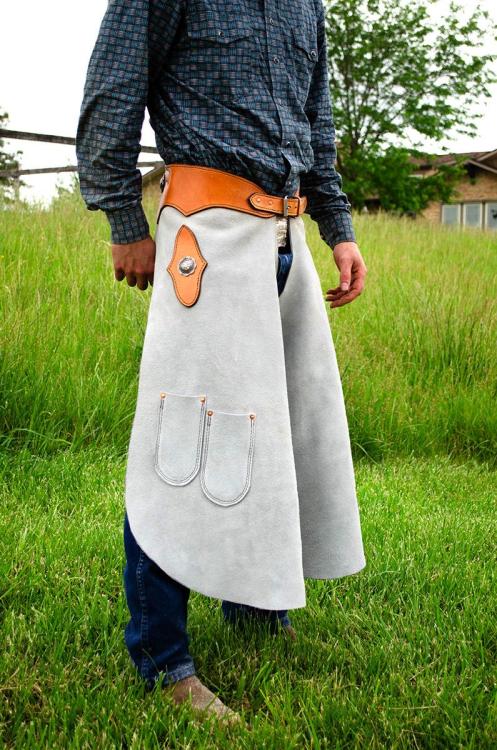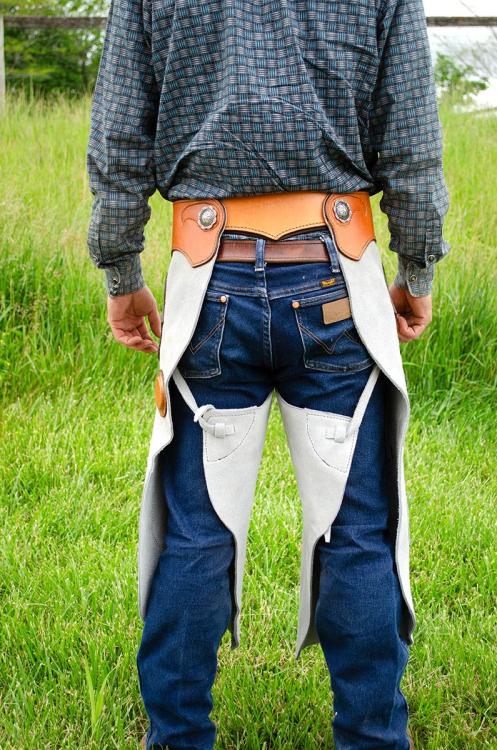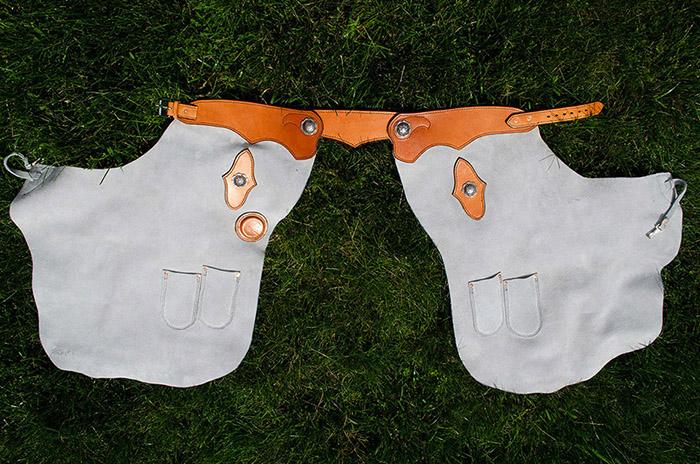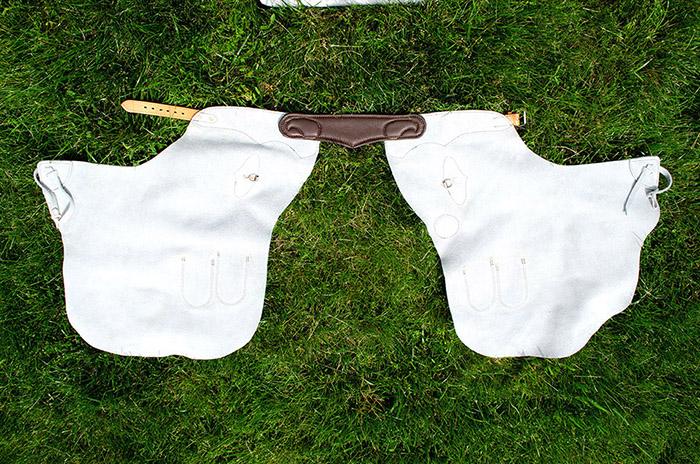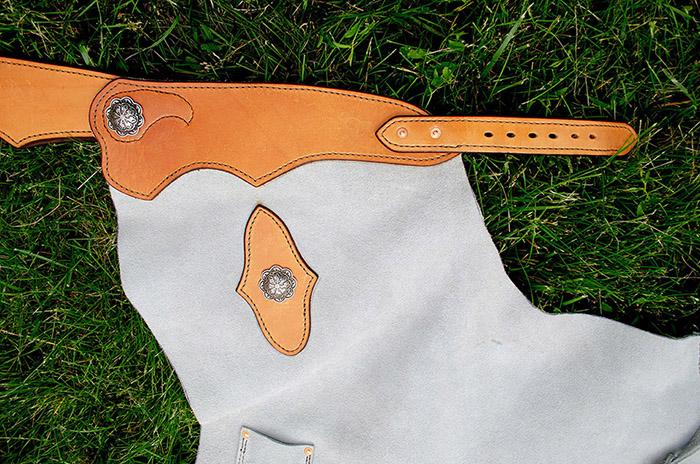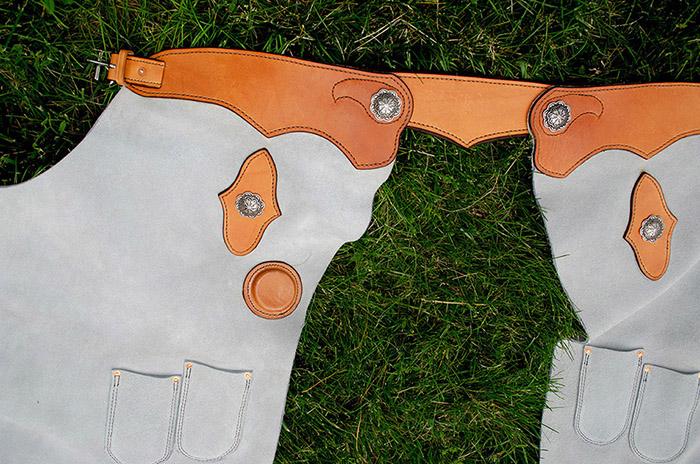-
Posts
1,282 -
Joined
-
Last visited
Content Type
Profiles
Forums
Events
Blogs
Gallery
Everything posted by TomE
-
I use a sponge or a wool dauber to apply BT639 then slick the surface with glass. Moss-back refers to the glue that tannerys used in the past for finishing the back of bridle leather - made from peat moss. I bought a slicker with smooth rounded edges from Springfield Leather Co. BT639 is available in quarts if you contact Campbell-Randall. You might try Tokonole first if it is more readily available.
- 19 replies
-
I've used this water soluble flexible adhesive for sealing the flesh side of leather https://campbell-randall.com/product/sup-bt639-g-leather-finish-for-sealing-flesh-side-moss-back-suede-1-gal. Tokonole also works. Can also apply wax with a heat gun. A glass slicker is useful for burnishing the flesh side.
- 19 replies
-
I haven't made many belts and not surprisingly they turned out looking like horse tack. If you plan to seal edges with beeswax you might look into using heat to help the wax penetrate the leather. I use Duane Watts' lollipop burnisher that I heat with an alcohol lamp. The video from Cary Schwarz shows an edge iron that I think he made. Similar to a Dixon edge iron.
- 19 replies
-
Definitely should tuck in the pant legs to show off those boots! Nice work.
-
A slightly damp edge will help the fibers compress into a smooth surface and a bit of lubricant (saddle soap, conditioner, etc) helps prevent overheating with the power burnisher. Need to find the right balance of moisture and friction to get the results you want. You sure can use beeswax or gumtrag to finish, but I find it easier to get a smooth, hard, shiney edge with Tokonole. I am guessing it is essentially glue in some type of slippery vehicle, probably silicone based like cyclomethicone used in hair products. A wax treatment might be a better choice for sealing the edge for outdoor use but it is more work and doesn't shine like Tokonole. For horse tack there's an expectation that it will be maintained by cleaning, conditioning and occasional oiling so I am not aiming to seal the leather. There are a lot of variables to play around with. Let us know how it goes.
- 19 replies
-
It is a small square of canvas that I use to apply saddle soap to the edge before power burnishing with the wooden Cobra burnisher. I've tried making a canvas sleeve to fit over the Cobra burnisher (either side) but the sleeves wear out quickly when burnishing 9-10 oz bridle leather. I guess I've experimented nonstop for several years with burnishing protocols. I've used gum tragacanth, water, saddle soap, Martin's Edge Solution, polyvinyl acetate (Elmer's white glue), beeswax +/- paraffin, a homemade paste of carnauba wax-beeswax-neatsfoot oil, and Tokonole. Slicking with canvas, wooden/plastic/bone burnishers, and the wooden power burnisher +/- a canvas sleeve. I've also done a topcoat of beeswax applied with a heated edge iron. All that stuff works, more or less. The biggest thing for success with a power burnisher is learning how much water and lubricant are needed to produce a slick edge without overheating. Just need to practice for your type of leather and burnishing machine. Here's my current protocol for bridle leather. I try to avoid sanding the edges unless they are really rough because edge finishing is already very time consuming, and sanding bridle leather can do more harm than good - the coarse fibers tend to pull up and the edge gets rougher. I apply Pro Dye to the edge with a block of heavy felt or Magic Eraser held in a clothespin (or use one of the refillable markers with the felt tip). Once the dye has soaked in but the edge is still damp I apply some saddle soap using a damp piece of canvas then immediately power burnish as a first pass. I then dab on Tokonole (or Elmer's glue diluted 4-5x with water), wait for it to become tacky, then power burnish. I finish by polishing the edge with a piece of dry canvas. If I'm going to further seal the edge I dab on softened beeswax and work it into the leather with a heated edge iron. I then rub the edge with a piece of canvas to remove excess wax. I guess I will continue to experiment and would enjoy hearing others' experiences. The HO bridle leather is difficult to slick, compared to regular veg tan, but I like its firm temper for horse tack. Wickett and Craig bridle has a softer temper and is easier to slick. HO traditional harness is waxy and easy to burnish. That's my 2 cents.
- 19 replies
-
Saddle soap is a good lubricant. I switched to Fiebings paste saddle soap applied to the edge with a damp piece of canvas. This works better for me than swiping a wet sponge on a bar of saddle soap, which delivers more water and less glycerin lubricant to the edge. I am using a Cobra burnisher set at about 2000 (?) rpm.
- 19 replies
-
You might look at commercially available lace bevelers for inspiration. https://y-knotlace.com/bevelers:25542
-
Ha! The rural version of plumber's butt.
-
Thanks, Jonas. Tried to incorporate methods I know. Thank you. Yes, I trim 15-20 of our broodmares and youngsters, and pay a farrier to shoe a couple that are in work and need shoes. I feel comfortable working on horses I know, and only have myself to blame if they act up. The apron is heavy but my farrier says he likes the 7oz split better than his worn out 6 oz apron.
-
Brain fart. I don’t normally add the quotes. Google for the save.
-
-
He is a world class farrier blacksmith. Makes it look easy.
-
@Northmount shared the tip to use Google to search this site instead of the built in search engine. In the Google search bar type ( site:"leatherworker.net" YOUR KEY WORDS HERE ) without the parentheses. I find this much better for finding old threads of interest.
-
Good looking collar and nice buckle! This reminds me of a Craig Trnka video showing how to make a bar shoe. He has a bigger surface to work on than you.
-
Thank you. Realized that the chrome tanned split might oxidize the copper rivets and turn them green. Not sure if brass rivets/burrs would oxidize. I'm not set up for steel tubular rivets, and I guess appearances aren't so important for this work apron. Thanks. I used one of his old aprons to make the pattern then tweaked the belt and back piece. He says these leather aprons last him several years, whereas the lighter nylon aprons with leather knee patches are nice in hot weather but wear out in 6 months.
-
Thank you. Thanks. Learned some new things.
-
Made an apron for a farrier friend. It buckles in front and has a padded back support. The apron wraps around the front of the legs and the straps clip to dee rings on the backside. Made from Beiler's 7 oz apron split and 9 oz Hermann Oak veg tan. It is heavy and unwieldy to feed through a sewing machine, but it is done.
-
Another satisfied customer with a Cobra burnisher. I frequently use the sanding drum to level up edges and the wooden burnisher has a variety of shapes that fit my projects.
-
My Techpro skiver doesn't have a boot on the universal joints. I purchased some FAV parts (steel feed roller, roller feet) from Campbell Randall in order to skive heavier veg tan leather. They were quite helpful and the parts fit nicely. I posted about it several months ago.
-
So the blade guard is used for working on the machine with the drive roller removed?
-
That's an interesting design, Jonas, and it looks very sturdy. Maybe you'll have to make one for Bent too.
-
I learned a lot about constructing leather projects from Stohlman's case making books. Instructions for knife sheaths are included.
-

Almost done with my Sanford & Son table
TomE replied to Southerngunner's topic in Leather Sewing Machines
That’s a nice piece of work! Wish I could weld like that. -

6 inch hollow ground Splitter blades need sharpening
TomE replied to Doc Reaper's topic in Sharpen it!
Nigel Armitage has a video on sharpening the blade of an Osborne #84 splitter. He swings the blade around 180 deg and leaves it clamped to the base of the splitter. That's what I do for my Taiwanese Tandy Pro splitter. Edited to add: That is the video posted above by @jcuk. Guess CS Osborne likes his method.- 11 replies
-
- splitter blades
- 6 inch splitter
- (and 3 more)



